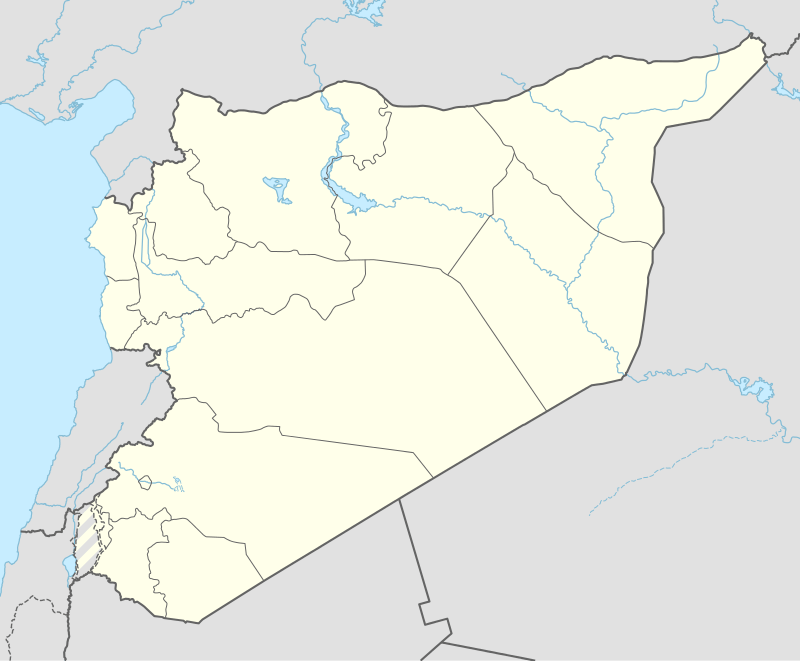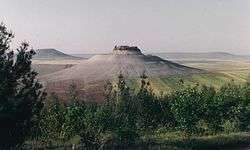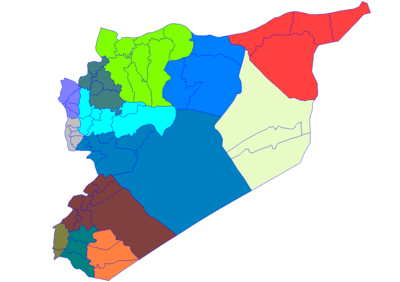Salamiyah
Salamiyah (Arabic: سلمية Salamīya) is a city and district in western Syria, in the Hama Governorate. It is located 33 kilometres (21 miles) southeast of Hama, 45 kilometres (28 miles) northeast of Homs. The city is nicknamed the "mother of Cairo" because it was the birthplace of the second Fatimid caliph al-Qa'im bi-Amr Allah, whose dynasty would eventually establish the city of Cairo, and the early headquarters of his father Abdullah al-Mahdi Billah who founded the Fatimid Caliphate. The city is an important center of the Shi'ite Nizari Isma'ili and Taiyabi Isma'ili Islamic schools and also the birthplace of poet Muhammad al-Maghut. The population of the city is 66,724 (2004 census).[1]
Salamiyah سلمية | |
|---|---|
 View of Salamiyah | |
| Nickname(s): The mother of Cairo | |
 Salamiyah Location in Syria | |
| Coordinates: 35°0′42.48″N 37°3′9″E | |
| Country | |
| Governorate | Hama |
| District | Salamiyah |
| Subdistrict | Salamiyah |
| Settled | 3500 BCE |
| Elevation | 475 m (1,558 ft) |
| Population (2004 census) | |
| • Total | 66,724 |
| • Ethnicities | Arab |
| • Religions | Ismailis, Alawites |
| Time zone | UTC+2 (EET) |
| • Summer (DST) | UTC+3 (EEST) |
| Area code(s) | 33 |

History
Salamiyah is an ancient city which was first known during Babylonian times in 3500 BC. It was the dwelled in by Sumerians at around 3000 BC, the Amorites around 2400 BC, the Aramaeans around 1500 BC, and the Nabateans around 500 BC. The city was destroyed for the first time by the Assyrians in the year 720 BC. After being rebuilt, the city was part of the Roman Empire and ruled by the Royal family of Emesa, a Roman Client Kingdom of Ancient Rome where they built the famous Chmemis Castle on the remains of a former volcano, 5 kilometres (3.1 miles) northwest of Salamiyah.
During the Byzantine Empire, Salamiyah existed as a Christian center with its own autocephalic Archbishop, until the city was destroyed for a second time during the Persian invasion of Syria of 637 during the Byzantine-Sassanid Wars by commander Kisra Ibrawiz who razed the city to the ground. The city was rebuilt again in the Islamic era by Abdullah ibn Saleh ibn Ali al-Abassi, the Abbasid governor of southern and center Syria, in 754 and was settled by some Hashimites during the Abbasid era, and al-Abbasi's son Muhammad ibn Abdullah ibn Saleh transformed the city into an important commercial center.[2]
According to Isma'ili Muslims, their Imam, Isma'il ibn Jafar died and was buried in the city after going into hiding during the eighth century. The city became the secret headquarters of the Isma'ili movement from the early ninth century until 902, it was from there that missionaries were originally sent for propagating the Isma'ili teachings in different regions. It was from Salamiyah, that the Isma'ili Imams secretly guided the activities of their followers from North Africa to Persia, Azerbaijan, and Central Asia. According to conflicting histories, the Isma'ili Imam, and first Fatimid Caliph, Abdullah al-Mahdi Billah was either born in Salamiyah or came to the city in 882 from Khuzistan, in modern-day Iran where he was raised by his uncle Abul Shalaghlagh the Hujjah (also called Lahiq) or leader of the Isma'ilis of Salamiyah, one of the twelve Isma'ili communities at the time. Abdullah's son Muhammad al-Qa'im bi-Amr Allah, an Isma'ili Imam and the second Fatimid Caliph, was born in Salamiyah in the late ninth century, and both left the city to establish the Fatimid state in northern Africa in the early tenth century.
After the death of Abul Shalaghlagh in 899, a dispute arose between Salamiyah Isma'ilis due to the fact that he left no male descendants and apparently had designated his nephew Abdullah as his spiritual successor and leader of the Salamiyah Isma'ili movement. Thereafter, a schism split the movement, provoked by Abdullah's claims on the imamate for himself and his descendants. Hamdan Qarmat and 'Abdan, who may have previously drifted slightly away from the doctrine propagated by the leadership, broke off their support. Qarmat's followers would eventually be known as the Qarmatians, and after Abdullah fled from Salamiyah to found the Fatimid Isma'ili state in North Africa in 899, the Qarmatis would reject the legitimacy of the Fatamids. In 903, Salamiyah was destroyed for the third time by an invasion from the rebel Qarmatians under Yahya ibn Zikrawayh.
Salamiyah is mentioned by historians as a very small town with limited rural settlement consequent to the Qarmatian invasion until the early Ottoman period wherein it was apparently deserted due to lack of protection from Bedouin attacks. Salamiyah was rebuilt when permission by the Ottoman Sultan Abdul Hamid II through a firman in July 1849 gave permission for the emigration of Isma'ilis led by Isma'il bin Muhammad, the Isma'ili amir of Qadmus in northern Syria. Isma'ilis from Qadmus and Masyaf among other smaller towns and villages emigrated to the newly rebuilt city which was first occupied by only sixteen families and by 1861, Salamiyah became an agricultural village. The final major Isma'ili immigration to Salamiyah occurred in 1919.
Salamiyah is currently the largest population center of Isma'ili Muslims in the Arab world. The remains of Prince Aly Khan, the father of the current Nizari Isma'ili Imam Aga Khan IV, are buried in the city. The headquarters of the Isma'ili Shia Higher Council of Syria are in the city, as are dozens of Jama'at Khana. During the mid-twentieth century, Salamiyah saw a growth of religious diversity with the building of the first Sunni mosque, and now the city is home to almost a dozen Sunni mosques and a Ja'fari Shia mosque in the city's Qadmusite Quarter which is home to most of the city's Ithna Ashari Shia which migrated to the city after ethnic and religious clashes in their hometown of Qadmus in the early twentieth century. Currently, a little more than half of the city's residents are Isma'ili.[3]
In 1934, Muhammad al-Maghut, the poet credit for being the father of free verse Arab poetry, was born in Salamiyah. In 1991, visitors from the Dawoodi Bohra sect of Isma'ili Shia Islam in Yemen built the Mosque of Imam Isma'il adjacent to the grave of the Isma'ili Imam Isma'il. The mosque was built by order of their leader the Da'i al-Mutlaq Mohammed Burhanuddin according to an inscription on the mosque's wall. Although currently used for worship by Sunni Muslims, the mosque and mausoleum are visited in religious pilgrimages by Dawoodi Bohra worldwide.

Salamiyah is located at the crossroads
From 2012 to 2017, with the development of frontlines in Syrian Civil War, the city grew in its strategic importance. With Al-Rastan becoming a pocket outside government control along the Homs-Hama Motorway, and the developments in Idlib governorate resulting in the government also losing control of large segments of the main Hama-Aleppo Highway, the Homs-Salamiyah, Hama-Salamiyah, and Salamiyah-Ithriya-Aleppo roads became major lines connecting these government-held areas. This importance was why the town was the target of occasional ISIL or rebel mortar attacks. Also, some of the town's citizens have participated in protests during the Civil War.[4] The importance of Salamiyah diminished following the Syrian Army's securing of the Homs-Hama Motorway on February 1, 2018, during the Northwestern Syria campaign.
Residence history of Salamiyah
The residence history of Salamiyah is as follows:[5]
"The Ismaili dais in search of a new residence for their Imam came to Salamia and inspected the town and approached the owner, Muhammad bin Abdullah bin Saleh, who had transformed the town into a flourishing commercial centre. They told him that there was a Hashimite merchant from Basra who was desirous of settling in the town. He readily accepted and pointed out to them a site along the main street in the market, where existed a house belonging to a certain Abu Farha. The Ismaili dais bought it for their Imam and informed him about it. Wafi Ahmad arrived to his new residence as an ordinary merchant. He soon pulled down the old building and had new ones built in its place; and also built a new wall around it. He also built a tunnel inside his house, leading to the desert, whose length was about 12 miles (19 kilometres). Money and treasures were carried on camels to the door of that tunnel at night. The door opened and the camels entered with their loads inside the house."
The photo placed here shows the mausoleum of the Imam. Near his kabra mubarak ("blessed grave"), the tunnel opening still exists.
Culture
The city is an agricultural center, with a largely agriculture based economy. Mate is extremely popular in Salamiyah and a drink of major cultural importance in social gatherings.
Main sights
- A hammam of unique architecture, likely dating from the Ayyubid era, sits in the town center, near a large underground Byzantine cistern which is said to lead all the way to Shmemis castle. There also exists one wall from an ancient Byzantine citadel.
- The castle, of Roman-Greek origins.
- Walls, rebuilt by Zengi
- Mosque of al-Imam Isma'il, which originated as an Ancient Greek temple of Zeus, and was turned into a church in Byzantine times.
- Remains of Roman canals, used for agriculture
Climate
Salamiyah has a cold semi-arid climate (Köppen climate classification BSk).
| Climate data for Salamiyah | |||||||||||||
|---|---|---|---|---|---|---|---|---|---|---|---|---|---|
| Month | Jan | Feb | Mar | Apr | May | Jun | Jul | Aug | Sep | Oct | Nov | Dec | Year |
| Average high °C (°F) | 11.3 (52.3) |
13.3 (55.9) |
17.3 (63.1) |
22.2 (72.0) |
28.4 (83.1) |
33.3 (91.9) |
35.1 (95.2) |
35.6 (96.1) |
32.5 (90.5) |
27.2 (81.0) |
19.3 (66.7) |
12.7 (54.9) |
24.0 (75.2) |
| Daily mean °C (°F) | 6.3 (43.3) |
7.9 (46.2) |
11.0 (51.8) |
15.1 (59.2) |
20.3 (68.5) |
24.6 (76.3) |
26.7 (80.1) |
26.9 (80.4) |
23.8 (74.8) |
19.0 (66.2) |
12.5 (54.5) |
7.8 (46.0) |
16.8 (62.3) |
| Average low °C (°F) | 1.4 (34.5) |
2.5 (36.5) |
4.8 (40.6) |
8.0 (46.4) |
12.3 (54.1) |
16.0 (60.8) |
18.3 (64.9) |
18.2 (64.8) |
15.2 (59.4) |
10.9 (51.6) |
5.7 (42.3) |
2.9 (37.2) |
9.7 (49.4) |
| Average precipitation mm (inches) | 57 (2.2) |
47 (1.9) |
38 (1.5) |
30 (1.2) |
14 (0.6) |
2 (0.1) |
0 (0) |
0 (0) |
1 (0.0) |
11 (0.4) |
27 (1.1) |
51 (2.0) |
278 (11) |
| Source: Climate-Data.org [6] | |||||||||||||
References
- Salamyah city population Archived 2013-01-13 at Archive.today
- See Ya'qubi, quoted in le Strange, 1890, p. 528
- Syria's diverse minorities, BBC, 9 December 2011
- http://english.al-akhbar.com/node/3679
- http://www.ismaili.net/histoire/history04/history419.html Wafi Ahmad in Salamia
- "Climate: Salamiyah". Climate-Data.org. Retrieved September 29, 2018.
Bibliography
- Le Strange, G. (1890). Palestine Under the Moslems: A Description of Syria and the Holy Land from A.D. 650 to 1500. Committee of the Palestine Exploration Fund.
- Sharon, M. (2007). Corpus Inscriptionum Arabicarum Palaestinae, Addendum. BRILL. p. 158
External links
- Google Satellite Image
- Ministry of Tourism
- https://web.archive.org/web/20070818010209/http://salamieh.reefnet.gov.sy/
- http://www.salamieh.com


